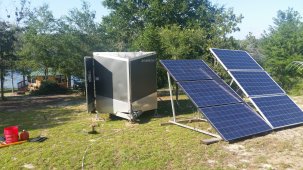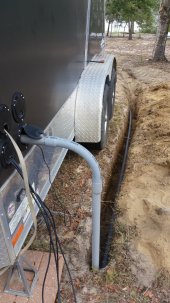I live in Florida where the sun heats everything, including the air itself, a bit hotter than I would like for my batteries to stay. I currently have a utility trailer that has AGM batteries in it, but they are dying from the heat. The plan is to remove the trailer, dig a pit three to four feet deep, and build up from there to make a shed that can keep its cool. The panels would shade the roof and south side of the shed. The other possibility is to dig two feet deep for the shed floor, then put a pit in the floor to house the battery box, which would then get its own insulated lid. The inverter and charge controller would then mount on the wall near the batteries. I expect to make the shed about 6X8 or so to allow room to move around in and store a few lawn tools, oars, etc.
I am not locked into any specific design, but I do have a picture in my head that includes cinder block walls. Obviously, the deeper I go the better for cooling, but excavation and building underground are a pain. It is all sand, so the only hard part about excavating is moving it and waterproofing the walls. Adding a drain to the battery pit for some catastrophic flood event would be pretty simple. I have considered just pouring a footer for the block and using a crushed stone floor so drainage is automagic.
A while back, @FilterGuy mentioned that he had some thoughts on using in-ground cooling for LFP banks. I do not use my power at the generation site, so I have 1-1/4" conduit 20 inches underground that run to my loads. One tube is downhill about 120 feet, and the other is uphill about 80 feet. I'm open to discussion of using the underground conduit to draw cool air into the shed to help keep it below about 86*F (30*C) or so.
Please feel free to ask questions or just discuss. I don't get cranky about hijacking, so let me read your thoughts! Thanks in advance.
This is the current setup (before we adjusted the panel angles).

And here is one of the conduit runs; the other is not installed yet in this photo, but goes the opposite direction.

I am not locked into any specific design, but I do have a picture in my head that includes cinder block walls. Obviously, the deeper I go the better for cooling, but excavation and building underground are a pain. It is all sand, so the only hard part about excavating is moving it and waterproofing the walls. Adding a drain to the battery pit for some catastrophic flood event would be pretty simple. I have considered just pouring a footer for the block and using a crushed stone floor so drainage is automagic.
A while back, @FilterGuy mentioned that he had some thoughts on using in-ground cooling for LFP banks. I do not use my power at the generation site, so I have 1-1/4" conduit 20 inches underground that run to my loads. One tube is downhill about 120 feet, and the other is uphill about 80 feet. I'm open to discussion of using the underground conduit to draw cool air into the shed to help keep it below about 86*F (30*C) or so.
Please feel free to ask questions or just discuss. I don't get cranky about hijacking, so let me read your thoughts! Thanks in advance.
This is the current setup (before we adjusted the panel angles).

And here is one of the conduit runs; the other is not installed yet in this photo, but goes the opposite direction.



